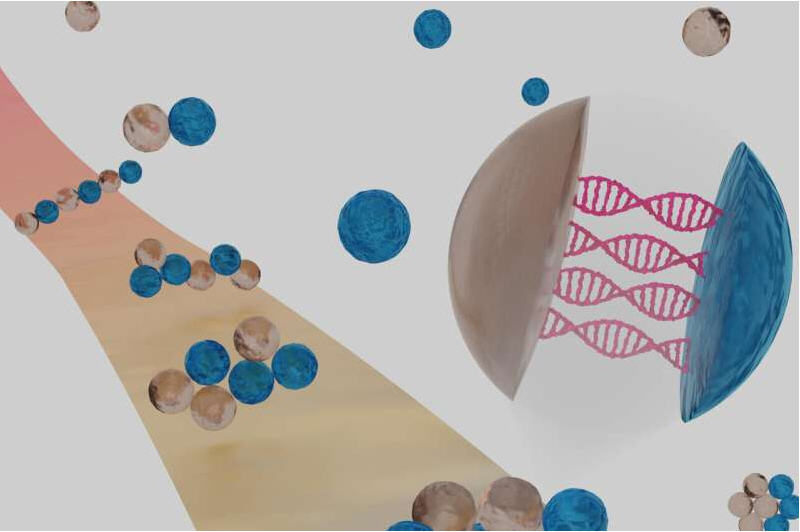博文
美法物理学家通过模仿生物学将自组装提升到新的水平
||
美法物理学家通过模仿生物学将自组装提升到新的水平
诸平


据美国纽约大学( New York University)2022年9月28日报道,美法物理学家通过模仿生物学将自组装提升到新的水平(Physicists take self-assembly to new level by mimicking biology)。
图1(Fig. 1)中显示了具有不同DNA链的液滴如何首先结合成链,然后通过编程将链折叠成特定的几何形状,类似于蛋白质折叠。地毯突出了六聚体链折叠成多面体的一条折叠路径。放大显示了DNA双螺旋的形成如何驱动液滴-液滴结合。
由美国纽约大学物理学家和法国巴黎文理研究大学(法文:Université PSL;英文:Paris Sciences & Lettres-PSL University,简称PSL)的物理学家组成的一个研究团队创造了一种新的自组装粒子的方法,这一进展为在微观水平上构建复杂和创新的材料提供了新的希望。
自组装技术于21世纪初引入,为科学家提供了一种“预编程”粒子的方法,使材料的制造无需进一步的人工干预,就像微观上的宜家家具(Ikea furniture)一样,可以自行组装。相关研究结果于2022年9月28日已经在《自然》(Nature)杂志网站发表——Angus McMullen, Maitane Muñoz Basagoiti, Zorana Zeravcic, Jasna Brujic. Self-assembly of emulsion droplets through programmable folding. Nature (2022). DOI: 10.1038/s41586-022-05198-8. Published: 28 September 2022. http://www.nature.com/articles/s41586-022-05198-8
发表在《自然》杂志上的这一突破性进展集中于浸没在水中的油滴乳液及其在非天然折叠体自组装中的应用,非天然折叠体是一种独特的形状,从理论上可以从液滴相互作用的顺序预测。
这种自组装过程(self-assembly process)借鉴了生物学领域的知识,利用胶体模拟蛋白质和RNA的折叠。发表在《自然》杂志的研究中,研究人员在水中创造出微小的油滴,这些油滴拥有一系列DNA序列,可以作为组装“指令”这些液滴首先组装成柔性链,然后通过粘性DNA分子依次折叠。这种折叠产生了十几种折叠类型,进一步的特异性可以编码600种可能几何形状中的一半以上。
图2(Fig. 2)中显微镜图像显示,一系列蓝黄相间的液滴通过蓝蓝、蓝黄、黄黄相互作用,在粘性DNA链的介导下,折叠成树冠几何体。如图所示,微小的液滴通过粘性DNA链相互作用,独特地折叠成清晰的形状。
纽约大学物理系教授、研究人员之一贾斯娜·布鲁吉克(Jasna Brujic)解释说:“能够对胶体结构进行预编程,使我们能够创造出具有复杂和创新特性的材料。我们的工作展示了如何独特地创建数百个自组装几何体,为创建下一代材料提供了新的可能性。”
纽约大学物理系博士后安格斯·麦克马伦(Angus McMullen)以及法国巴黎文理研究大学巴黎高等物理化学学院(ESPCI)的迈坦·穆诺兹·巴萨戈蒂(Maitane Muñoz Basagoiti)和佐拉娜·泽拉维奇(Zorana Zeravcic)也参与了这项研究。
科学家们强调了该方法的反直觉和开创性:与其需要大量的构建块来编码精确的形状,它的折叠技术意味着只需要少量的构建块,因为每个块可以采用多种形式。
贾斯娜·布鲁吉克解释道:“与拼图( jigsaw puzzle)不同的是,我们的过程只使用两种类型的粒子,这大大减少了编码特定形状所需的构建块的种类。创新之处在于使用类似于蛋白质的折叠方式,但长度大约是头发宽度的1/10。这些粒子首先结合在一起形成一条链,然后根据预先编程的相互作用进行折叠,引导链通过复杂的路径形成独特的几何结构。”
她补充道:“获得形状词库的能力为进一步组装成更大规模的材料开辟了道路,就像蛋白质在生物学中按层次聚集以构建细胞室一样。”
这项工作由巴黎大区(Région Île-de-France)在布莱斯·帕斯卡尔国际杰出会议主席(Blaise Pascal International Chairs of Excellence)的支持下进行。得到了美国国家科学基金会MRSEC项目(MRSEC programme of the National Science Foundation under grants No. NSF DMR-1420073, No. NSF PHY17-48958 and No. NSF DMR-1710163)、欧盟的地平线2020研究和创新项目、法国玛丽·斯库多夫斯卡-居里赠款(European Union’s Horizon 2020 research and innovation programme under the Marie Skłodowska-Curie grant agreement No. 754387)以及巴黎市EMERGENCE(S)赠款(Paris EMERGENCE(S) grant)的支持。
上述介绍,仅供参考。欲了解更多信息,敬请注意浏览原文或者相关报道。
物理学家发现粒子如何自组装(Physicists discover how particles self-assemble)
In the realm of particle self-assembly, it is possible to reliably construct nearly arbitrary structures if all the pieces are distinct1,2,3, but systems with fewer flavours of building blocks have so far been limited to the assembly of exotic crystals4,5,6. Here we introduce a minimal model system of colloidal droplet chains7, with programmable DNA interactions that guide their downhill folding into specific geometries. Droplets are observed in real space and time, unravelling the rules of folding. Combining experiments, simulations and theory, we show that controlling the order in which interactions are switched on directs folding into unique structures, which we call colloidal foldamers8. The simplest alternating sequences (ABAB...) of up to 13 droplets yield 11 foldamers in two dimensions and one in three dimensions. Optimizing the droplet sequence and adding an extra flavour uniquely encodes more than half of the 619 possible two-dimensional geometries. Foldamers consisting of at least 13 droplets exhibit open structures with holes, offering porous design. Numerical simulations show that foldamers can further interact to make complex supracolloidal architectures, such as dimers, ribbons and mosaics. Our results are independent of the dynamics and therefore apply to polymeric materials with hierarchical interactions on all length scales, from organic molecules all the way to Rubik’s Snakes. This toolbox enables the encoding of large-scale design into sequences of short polymers, placing folding at the forefront of materials self-assembly.
https://blog.sciencenet.cn/blog-212210-1357595.html
上一篇:[转载]祝愿祖国繁荣昌盛,祝福朋友节日快乐
下一篇:ESI期刊知多少